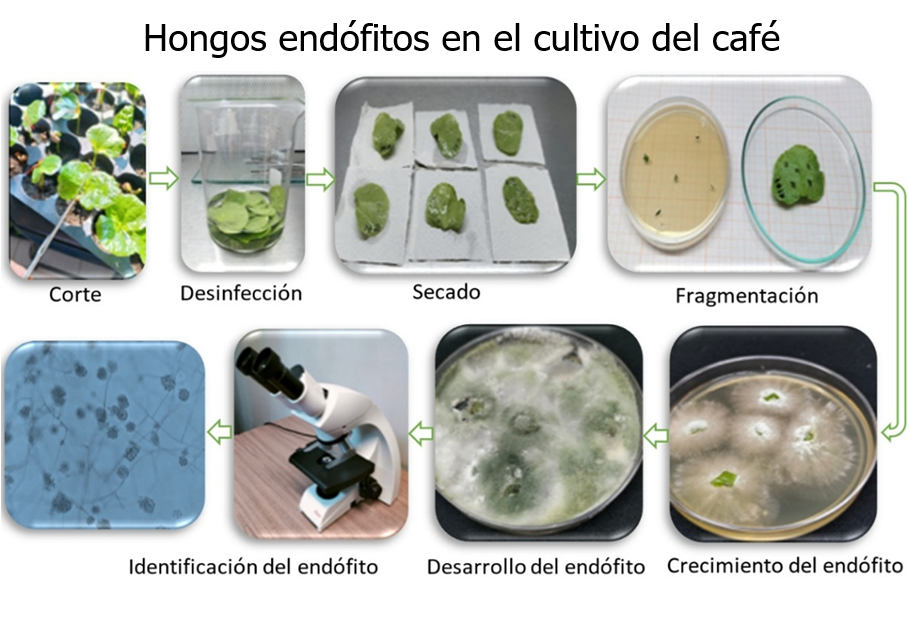Strains of Akanthomyces uredinophilum, Simplicillium lanosoniveum, and Trichoderma spp. exhibit high endophytic activity and induce improved growth of coffee plants
DOI:
https://doi.org/10.17268/sci.agropecu.2025.029Keywords:
Coffea arabica, endophytic fungi, plant growth, diseaseAbstract
The cultivation of coffee (Coffea arabica L.) is affected by rust (Hemileia vastatrix), causing losses of over 70% in production. The use of endophytic fungi is a biological strategy for disease control. The objective of this study was to evaluate the endophytic activity of 14 fungal strains and their effect on the growth of coffee plants var. Caturra. Coffee seeds were inoculated with a concentration of 1×106 conidia mL-1 of water, planted and organized in a completely randomized experimental design, with three repetitions of eight plants per strain. At 30, 60, and 120 days after seedling emergence, samples of five leaf segments per plant, 5 mm in diameter, were taken to evaluate endophytic activity. The start of fungal growth (days), initial fungal growth (%) and total fungal growth (%) were recorded. To evaluate the effect of fungal strains on the growth of coffee plants, plant height, stem diameter, number of leaves, leaf pairs, number of branches and chlorophyll content index were evaluated. Analysis of Variance and Tukey's mean separation test (p ≤ 0.05) were performed. Three strains of A. uredinophilum (CHE-CNRCB 435, 616, and 988), two of S. lanosoniveum (CHE-CNRCB 438 and 544), and three of Trichoderma (CHE-CNRCB 398, 1057, and 1062) showed endophytic activity higher than 70%. The three Trichoderma spp. strains induced better growth in coffee plants.
References
Abbas, A., Mubeen, M., Zheng, H., Sohail, M. A., Shakeel, Q., et al. (2022). Trichoderma spp. genes involved in the biocontrol activity against Rhizoctonia solani. Frontiers in Microbiology, 13, 884469. https://doi.org/10.3389/fmicb.2022.884469
Aristizábal, L. F. & Johnson, M. A. (2022). Monitoring coffee leaf rust (Hemileia vastatrix) on commercial coffee farms in Hawaii: early insights from the first year of disease incursion. Agronomy, 12(5), 1134-1149. https://doi.org/10.3390/agronomy12051134
Barnett, H. L., & Hunter, B. B. (1972). Illustrated genera of imperfect fungi. Minneapolis: Burges Publ. com., 241 p.
Bongiorno, V. A., Rhoden, S.A., Garcia, A., Polonio, J. C., Azevedo, J. L. Pereira, J. O., & Pamphile, J. A. (2016). Genetic diversity of endophytic fungi from Coffea arabica cv. IAPAR-59 in organic crops. Annals of Microbiology, 66, 855-865. https://doi.org/10.1007/s13213-015-1168-0
Castillo, N. E. T., Acosta, Y. A., Parra-Arroyo, L., Martínez-Prado, M. A., Rivas-Galindo, V. M., Iqbal, H. M. N., Bonaccorso, A. D., Melchor-Martínez, E. M., & Parra-Saldívar, R. (2022). Towards an eco-friendly coffee rust control: Compilation of Natural Alternatives from a Nutritional and Antifungal Perspective. Plants, 11, 2745. https://doi.org/10.3390/plants11202745
Coa-Urbaez, M., Mendez N., J. R., Silva A. R., & Mundarain, P. S. (2014). Evaluación de métodos químicos y mecánicos para promover la germinación de semillas y producción de fosforitos en café (Coffea arabica) var. Catuaí Rojo. Idesia (Arica), 32(1), 43-53. http://dx.doi.org/10.4067/S0718-34292014000100006
Collinge, D. B., Jensen, B., & Jorgensen, J. L. H. (2022). Fungal endophytes in plants and their relationship to plant disease. Current Opinion in Microbiology, 69, 102177. https://doi.org/10.1016/j.mib.2022.102177
De Silva, N. I., Brooks, S., Lumyong, S., & Hyde, K. D. (2019). Use of endophytes as biocontrol agents. Fungal Biology Reviews, 33(2), 133-148. https://doi.org/10.1016/j.fbr.2018.10.001
Dugan, F. M. (2017). The identification of fungi: an illustrated introduction with keys, glossary, and guide to literature. The American Phytopathological Society, Minnesota, 176 p., https://doi.org/10.1094/9780890545041
Ek-Ramos, M. J. (2020). Endófitos microbianos para el control de plagas y enfermedades agrícolas, Fundamento y práctica del control biológico de plagas y enfermedades. Editorial del Colegio de Postgraduados 1ra ed., Cap. 17, pp.373-405.
Fontana, D. C., de Paula, S., Torres, A. G., de Souza, V. H. M., Pascholati, S. F, Schmidt, D., & Dourado, N. D. (2021). Endophytic fungi: Biological control and induced resistance to phytopathogens and abiotic stresses. Pathogens, 10(5), 570. https://doi.org/10.3390/pathogens10050570
Geisen, S., Kostenko, O., Cnossen, M. C., Ten Hooven, F. C., Vres, B., & Van Der Putten, W. H. (2017). Seed and root endophytic fungi in a range expanding and a related plant species. Frontiers in microbiology, 8, 1645. https://doi.org/10.3389/fmicb.2017.01645
Herrera-Estrella, A., & Chet, I. (2004). The biological control agent Trichoderma from fundamentals to applications. Mycology Series, 21, 147-156. https://doi.org/10.1016/j.biocontrol.2012.01.004
INFOBAE. (2024). La incesante crisis de café en Chiapas que ha provocado el éxodo de miles de campesinos. https://www.infobae.com/america/mexico/2019/04/20/la-incesante-crisis-de-cafe-en-chiapas-que-ha-provocado-el-exodo-de-miles-de-campesinos/
Jaber, L. R., & Enkerli, J. (2017). Fungal entomopathogens as endophytes: can they promote plant growth? Biocontrol Science and Technology, 27(1), 28-41. https://doi.org/10.1080/09583157.2016.1243227
Jackson, D., Skillman, J., & Vandermeer, J. (2012). Indirect biological control of the coffee leaf rust, Hemileia vastatrix, by the entomogenous fungus Lecanicillium lecanii in a complex coffee agroecosystem. Biological control, 61(1), 89-97. https://doi.org/10.1016/j.biocontrol.2012.01.004
Ku, Y. S., Cheng, S. S., Gerhardt, A., Cheung, M. Y., Contador, C. A., Poon, L. Y. W., & Lam, H. M. (2020). Secretory peptides as bullets: effector peptides from pathogens against antimicrobial peptides from soybean. International Journal of Molecular Sciences, 21(23), 9294. https://doi.org/10.3390/ijms21239294
Libert, A., A., Ituarte-Lima, C., & Elmqvist, T. (2020). Learning from social-ecological crisis for legal resilience building: Multi-scale dynamics in the coffee rust epidemic. Sustainability Science, 15, 485-501. https://doi.org/10.1007/s11625-019-00703-x
Liu, Y., Yang, Y., & Wang, B. (2022). Entomopathogenic fungi Beauveria bassiana and Metarhizium anisopliae play roles of maize (Zea mays) growth promoter. Scientific reports, 12(1), 15706. https://doi.org/10.1038/s41598-022-19899-7
Mamani-Huayhua, G., Leon-Ttacca, B., Palao-Iturregui, L. A., & Borja-Loza, Y. R. (2021). Biocontrol of coffee yellow rust (Hemileia vastatrix Berk. & Br.) with Trichoderma sp. endophyte strains. Cultivos Tropicales, 42(4), e01.
Marro, N., Grilli, G., Soteras, F., Caccia, M., Longo, S., Cofré, N., & Urcelay, C. (2022). The effects of arbuscular mycorrhizal fungal species and taxonomic groups on stressed and unstressed plants: a global meta‐analysis. New Phytologist, 235(1), 320-332. https://doi.org/10.1111/nph.18102
Navaneetha, T., Prasad, R. D., & Rao, L.V. (2015). Liquid formulation of Trichoderma species for management of gray mold in castor (Ricinus communis L.) and alternaria leaf blight in sunflower (Helianthus annuus L.). Journal of Biofertilizers & Biopesticides, 6(1), 149.
Nicoletti, R. & Becchimanzi, A. (2020). Endophytism of Lecanicillium and Akanthomyces. Agriculture, 10, 205. https://www.doi.org/10.3390/agriculture10060205
Ortega, H. E., Torres-Mendoza, D., & Cubilla-Ríos, L. (2020). Patents on endophytic fungi for agriculture and bio- and phytoremediation applications. Microorganisms, 8(8), 1237. https://doi.org/10.3390/microorganisms8081237
Parra, M., S. (2023). Microbiología del vermicompost. Universidad de los Andes. http://hdl.handle. net/1992/64905
Ramírez, R. J., & Cerda, R. (2021). Fertilización del cafeto [Guía], Folleto, Ministerio de Medio Ambiente y Recursos Naturales, Proyecto Biodiversidad en Paisajes Productivos, Santo Domingo RD, 16 p. https://bvearmb.do/handle/123456789/3332
Rodrigo, S., Santamaria, O., Halecker, S., Lledó, S., & Stadler, M. (2017). Antagonism between Byssochlamys spectabilis (anamorph Paecilomyces variotii) and plant pathogens: Involvement of the bioactive compounds produced by the endophyte. Annals of Applied Biology, 171(3), 464-476. https://doi.org/10.1111/aab.12388
Rojas, E. C., Jensen, B., Jorgensen, H. J., Latz, M. A., Esteban, P., Ding, Y., & Collinge, D. B. (2020). Selection of fungal endophytes with biocontrol potential against Fusarium head blight in wheat. Biological Control, 144, 104222. https://doi.org/10.1016/j.biocontrol.2020.104222
Rosa, L. H., Tabanca, N., Techen, N., Pan, Z., Wedge, D. E., & Moraes, R. M. (2012). Antifungal activity of extracts from endophytic fungi associated with Smallanthus maintained in vitro as autotrophic cultures and as pot plants in the greenhouse. Canadian journal of Microbiology, 58(10), 1202-1211. https://doi.org/10.1139/w2012-088
Rosales-Castillo, R., Velázquez-de Lucio, B. S., Hernández-Domínguez, E. M., & Álvarez-Cervantes, J. (2025). Bioinsumos: una alternativa para lograr una agricultura sostenible. Terra Latinoamericana, 43, 1-15. https://doi.org/10.28940/terra.v43i.2045
Sandoval, V., M. C. & Noelting, Z. M. C. I. (2011). Producción de conidios de Trichoderma harzianum Rifai en dos medios de multiplicación. Fitosanidad, 15(4), 215-221.
SAS Institute Inc. (1995). SAS/STAT User ́s guide, Version 9,2. SAS Institute. Cary, NC.
SENASICA. (2022). Roya del cafeto (Hemileia vastatrix Berkeley & Broome). Dirección General de Sanidad Vegetal-Programa de Vigilancia Epidemiologica Fitosanitaria Cd. de México.
SIACON. (2024). Sistema de Información Agroalimentaria de Consulta https://www.gob.mx/agricultura/es/articulos/mexico-onceavo-productor-mundial-de-cafe
Suebrasri, T., Harada, H., Jogloy, S., Ekprasert, J., & Boonlue, S. (2020). Auxin-producing fungal endophytes promote growth of sunchoke. Rhizosphere, 16, 100271. https://doi.org/10.1016/j.rhisph.2020.100271
Tall, S., & Meyling, N. V. (2018). Probiotics for plants? Growth promotion by the entomopathogenic fungus Beauveria bassiana depends on nutrient availability. Microbial ecology, 76(4), 1002-1008.
Vandermeer, J., Perfecto, I., & Liere, H. (2009). Evidence for hyperparasitism of coffee rust (Hemileia vastatrix) by the entomogenous fungus, Lecanicillium lecanii, through a complex ecological web. Plant Pathology, 58(4), 636-641. https://doi.org/10.1111/j.1365-3059.2009.02067.x
Vega, F. E., Simpkins, A., Aime, M. C., Posada, F., Peterson, S. W., Rehner, S. A., & Arnold, A. E. (2010). Fungal endophyte diversity in coffee plants from Colombia, Hawai'i, Mexico and Puerto Rico. Fungal ecology, 3(3), 122-138. https://doi.org/10.1016/j.funeco.2009.07.002

Published
How to Cite
Issue
Section
License
Copyright (c) 2025 Scientia Agropecuaria

This work is licensed under a Creative Commons Attribution-NonCommercial 4.0 International License.
The authors who publish in this journal accept the following conditions:
a. The authors retain the copyright and assign to the magazine the right of the first publication, with the work registered with the Creative Commons attribution license, which allows third parties to use the published information whenever they mention the authorship of the work and the First publication in this journal.
b. Authors may make other independent and additional contractual arrangements for non-exclusive distribution of the version of the article published in this journal (eg, include it in an institutional repository or publish it in a book) as long as it clearly indicates that the work Was first published in this journal.
c. Authors are encouraged to publish their work on the Internet (for example, on institutional or personal pages) before and during the review and publication process, as it can lead to productive exchanges and a greater and faster dissemination of work Published (see The Effect of Open Access).




